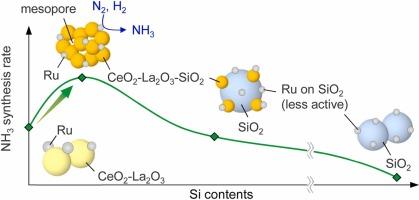Design of ammonia synthesis Ru catalysts with mesoporous structures through the Si-doping of cerium–lanthanum oxide
IF 4.8
2区 化学
Q2 CHEMISTRY, PHYSICAL
引用次数: 0
Abstract
Green ammonia has attracted growing attention as an energy carrier to facilitate the storage and transport of hydrogen that is derived from renewable energy sources. It is therefore necessary to develop catalysts that can efficiently synthesize ammonia under milder conditions (<10 MPa) than those required by conventional catalysts (15–30 MPa). In this study, Si is doped into Ru/CeO2-La2O3 catalysts prepared via a polymerization complexation method to promote the synthesis of ammonia over the generated mesoporous structure. Scanning electron microscopy, X-ray diffractometry, N2 adsorption, attenuated total reflection–Fourier transform infrared spectrometry, and CO adsorption measurements revealed that for the CeO2-La2O3 support, Si doping at levels of ≤ 10 mol% created a mesoporous structure (10–50 nm range) through aggregation of the CeO2-La2O3-SiO2 solid solution with a smaller particle size than that of undoped particles. Consequently, this resulted in an enhanced Ru dispersion and an improved catalytic activity. However, Si doping at levels > 10 mol% led to the formation of isolated SiO2 particles bearing inactive Ru species, thereby resulting in a lower catalytic activity. Notably, compared to the catalyst without Si doping, the 10 mol% Si-doped Ru/CeO2-La2O3-SiO2 catalyst exhibited a 3.5-fold higher rate for ammonia synthesis at a reaction pressure of 5.1 MPa. This system is therefore expected to promote ammonia synthesis under mild conditions, ultimately contributing to the transition from a fossil fuel-based society to a hydrogen-based society.

采用硅掺杂铈-氧化镧制备介孔结构氨合成钌催化剂
绿色氨作为一种能源载体,促进了可再生能源中氢的储存和运输,引起了越来越多的关注。因此,有必要开发出比传统催化剂(15-30 MPa)更温和的条件下(<10 MPa)高效合成氨的催化剂。本研究将Si掺杂到聚合络合法制备的Ru/CeO2-La2O3催化剂中,在生成的介孔结构上促进氨的合成。扫描电镜、x射线衍射、N2吸附、衰减全反射-傅里叶变换红外光谱和CO吸附测量结果表明,对于CeO2-La2O3载体,Si掺杂≤ 10 mol%时,通过聚集CeO2-La2O3- sio2固溶体形成了介孔结构(10 - 50 nm范围),其颗粒尺寸小于未掺杂的颗粒。因此,这导致了Ru分散的增强和催化活性的提高。然而,当Si掺杂在>; 10 mol%水平时,会形成含有活性Ru的分离SiO2颗粒,从而导致催化活性降低。值得注意的是,在反应压力为5.1 MPa时,掺Si为10 mol%的Ru/CeO2-La2O3-SiO2催化剂的氨合成速率比未掺Si的催化剂高3.5倍。因此,该系统有望在温和条件下促进氨合成,最终促进从化石燃料社会向氢基础社会的过渡。
本文章由计算机程序翻译,如有差异,请以英文原文为准。
求助全文
约1分钟内获得全文
求助全文
来源期刊

Applied Catalysis A: General
化学-环境科学
CiteScore
9.00
自引率
5.50%
发文量
415
审稿时长
24 days
期刊介绍:
Applied Catalysis A: General publishes original papers on all aspects of catalysis of basic and practical interest to chemical scientists in both industrial and academic fields, with an emphasis onnew understanding of catalysts and catalytic reactions, new catalytic materials, new techniques, and new processes, especially those that have potential practical implications.
Papers that report results of a thorough study or optimization of systems or processes that are well understood, widely studied, or minor variations of known ones are discouraged. Authors should include statements in a separate section "Justification for Publication" of how the manuscript fits the scope of the journal in the cover letter to the editors. Submissions without such justification will be rejected without review.
 求助内容:
求助内容: 应助结果提醒方式:
应助结果提醒方式:


